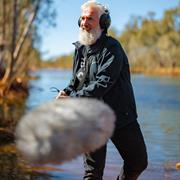
Professor Philip Samartzis
Details
-
Department: School of Art
-
Campus: City Campus Australia
-
philip.samartzis@rmit.edu.au
-
ORCID: 0000-0002-9012-8715
Open to
- Media enquiries
- Masters Research or PhD student supervision
About
Research fields
- 360602 Fine arts
- 360699 Visual arts not elsewhere classified
UN sustainable development goals
- 13 Climate Action
Supervisor projects
- teebeluck kormtenner timmarerer, white devils spirit basket.
- 7 Feb 2025
- HOLOENT ATLAS -BIRDS CHAPTER
- 3 Feb 2025
- Meta-Mangrovis : Perception of Ecological Transformation of Mangrove Landscapes through Contemporary Sonic Arts Practice
- 4 Dec 2023
- Melting Icescapes / Black Landscapes: Visualising Glacial Melt in the Khumbu, Nepal Himalayas
- 8 Feb 2023
- Whelm: An Exploratory Practice of Soft Fascination through the Infinite Paths of an Entheogenic Garden
- 10 Dec 2021
- The Smallest Measure: Signifiers of Atmospheres in Transformation
- 8 Dec 2021
- Porosity of the Frame: Material Experiments on the Boundary between Art and Everyday Life
- 6 Aug 2021
- Noisemaker: In Search of Indian Noise Music
- 26 Oct 2020
- Sound of Spaces: Spaces from Sound.
- 9 Sep 2020
- Being Weird: Collaboration, Contamination, and Worlding with Nonhumans
- 15 Mar 2019
- The Bruiteur: Noise and Listening in Performance
- 27 Feb 2019
- Sounding Transformation in Three Cities: Articulating encounters of sonic shifts in Kaifeng, Melbourne and Suzhou through field recording practice and sound composition
- 22 Feb 2016
- Halfway to Paradise: documenting people and place, fictional constructs and considerations for post-documentary
- 17 Sep 2015
- Site unseen: perception of place within contemporary sonic arts practices
- 5 Jan 2015
- Fields of Resonance: Towards Embodied Forms of Listening and Looking
- 3 Jan 2014
- Spatial Audio Engineering: exploring height in acoustic space
- 1 Apr 2013
Teaching interests
Supervisor interest areas:
Sound Art
Experimental Music
Acoustic Ecology
Antarctica
Alpine Ecologies
Program:
BP201 – Bachelor of Arts (Fine Art) (https://www.rmit.edu.au/study-with-us/art/fine-and-visual-art)
Supervisor projects:
• Jessie Boylen: The Smallest Measure: signifiers of atmospheres in transformation
• K Sukirthalingam Kanagalingam: Melting Icescapes / Black Landscapes – Visualising Glacial Melt in the Nepal Himalayas
• Justas Pipinis: Porosity of the Frame: Material experiments on the boundary between art and everyday life
• Pratyay Raha: Investigating the role and application of contemporary sound arts in simulating and studying mangrove forest environments
• Adele Wilkes: Infinite Paths through the Poison Garden: Alternative Ontologies to Anthropocentrism
Research interests
Philip Samartzis is a Chief Investigator on the ARC Discovery Project Creative Antarctica: Artists and Writers in the Far South and is the recipient of three Australian Antarctic Territory Fellowships which he is using to map the soundscape of Eastern Antarctica. He is the recipient of a Swiss National Science Foundation Fellowship, and Creative Australia International Engagement grant to record the impact of climate change on high altitude alpine ecologies. His research has been presented nationally and internationally including the National Gallery of Victoria; the Art Gallery of NSW; the Art Gallery of South Australia; the Intercommunication Centre in Tokyo; and the San Francisco Museum of Modern Art.
Research keywords:
Sound Art, Soundscape, Eco-Acoustics, Acoustic Ecology, Bioacoustics, Antarctica, Alpine Environments
Awards:
2024 RMIT Research Award for Engagement and Impact
2021 ACUADS Distinguished Research Award
2021 GEO Art Prize - Video and Music Category for Atmospheres and Disturbances
2019 Prix ARS Electronica Honorary Mention for Digital Musics & Sound Art for Polar Force (with Eugene Ughetti)


